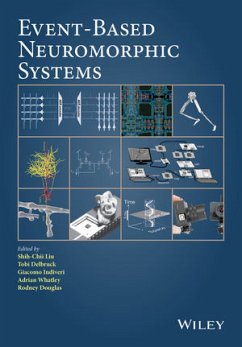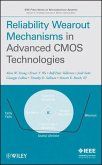Event-Based Neuromorphic Systems (eBook, PDF)
Redaktion: Liu, Shih-Chii; Douglas, Rodney; Whatley, Adrian; Indiveri, Giacomo; Delbruck, Tobi


Alle Infos zum eBook verschenken

Event-Based Neuromorphic Systems (eBook, PDF)
Redaktion: Liu, Shih-Chii; Douglas, Rodney; Whatley, Adrian; Indiveri, Giacomo; Delbruck, Tobi
- Format: PDF
- Merkliste
- Auf die Merkliste
- Bewerten Bewerten
- Teilen
- Produkt teilen
- Produkterinnerung
- Produkterinnerung

Hier können Sie sich einloggen

Bitte loggen Sie sich zunächst in Ihr Kundenkonto ein oder registrieren Sie sich bei bücher.de, um das eBook-Abo tolino select nutzen zu können.
Neuromorphic electronic engineering takes its inspiration from the functioning of nervous systems to build more power efficient electronic sensors and processors. Event-based neuromorphic systems are inspired by the brain's efficient data-driven communication design, which is key to its quick responses and remarkable capabilities. This cross-disciplinary text establishes how circuit building blocks are combined in architectures to construct complete systems. These include vision and auditory sensors as well as neuronal processing and learning circuits that implement models of nervous systems.…mehr
- Geräte: PC
- mit Kopierschutz
- eBook Hilfe
- Größe: 19.8MB
![Event-Based Neuromorphic Systems (eBook, ePUB) Event-Based Neuromorphic Systems (eBook, ePUB)]() Event-Based Neuromorphic Systems (eBook, ePUB)92,99 €
Event-Based Neuromorphic Systems (eBook, ePUB)92,99 €![Analog VLSI Circuits for the Perception of Visual Motion (eBook, PDF) Analog VLSI Circuits for the Perception of Visual Motion (eBook, PDF)]() Alan A. StockerAnalog VLSI Circuits for the Perception of Visual Motion (eBook, PDF)121,99 €
Alan A. StockerAnalog VLSI Circuits for the Perception of Visual Motion (eBook, PDF)121,99 €![Human Memory Modeled with Standard Analog and Digital Circuits (eBook, PDF) Human Memory Modeled with Standard Analog and Digital Circuits (eBook, PDF)]() John Robert BurgerHuman Memory Modeled with Standard Analog and Digital Circuits (eBook, PDF)163,99 €
John Robert BurgerHuman Memory Modeled with Standard Analog and Digital Circuits (eBook, PDF)163,99 €![Selective Visual Attention (eBook, PDF) Selective Visual Attention (eBook, PDF)]() Liming ZhangSelective Visual Attention (eBook, PDF)123,99 €
Liming ZhangSelective Visual Attention (eBook, PDF)123,99 €![Sneak Circuits of Power Electronic Converters (eBook, PDF) Sneak Circuits of Power Electronic Converters (eBook, PDF)]() Bo ZhangSneak Circuits of Power Electronic Converters (eBook, PDF)128,99 €
Bo ZhangSneak Circuits of Power Electronic Converters (eBook, PDF)128,99 €![The Autonomous System (eBook, PDF) The Autonomous System (eBook, PDF)]() Szabolcs Michael De GyurkyThe Autonomous System (eBook, PDF)104,99 €
Szabolcs Michael De GyurkyThe Autonomous System (eBook, PDF)104,99 €![Reliability Wearout Mechanisms in Advanced CMOS Technologies (eBook, PDF) Reliability Wearout Mechanisms in Advanced CMOS Technologies (eBook, PDF)]() Alvin W. StrongReliability Wearout Mechanisms in Advanced CMOS Technologies (eBook, PDF)166,99 €
Alvin W. StrongReliability Wearout Mechanisms in Advanced CMOS Technologies (eBook, PDF)166,99 €-
-
-
Dieser Download kann aus rechtlichen Gründen nur mit Rechnungsadresse in A, B, BG, CY, CZ, D, DK, EW, E, FIN, F, GR, HR, H, IRL, I, LT, L, LR, M, NL, PL, P, R, S, SLO, SK ausgeliefert werden.
- Produktdetails
- Verlag: John Wiley & Sons
- Seitenzahl: 440
- Erscheinungstermin: 23. Dezember 2014
- Englisch
- ISBN-13: 9781118927632
- Artikelnr.: 42088023
- Verlag: John Wiley & Sons
- Seitenzahl: 440
- Erscheinungstermin: 23. Dezember 2014
- Englisch
- ISBN-13: 9781118927632
- Artikelnr.: 42088023
Abbreviations and Acronyms xxi 1 Introduction 1 1.1 Origins and Historical
Context 3 1.2 Building Useful Neuromorphic Systems 5 References 5 Part I
UNDERSTANDING NEUROMORPHIC SYSTEMS 7 2 Communication 9 2.1 Introduction 9
2.2 Address-Event Representation 12 2.2.1 AER Encoders 13 2.2.2 Arbitration
Mechanisms 13 2.2.3 Encoding Mechanisms 17 2.2.4 Multiple AER Endpoints 19
2.2.5 Address Mapping 19 2.2.6 Routing 19 2.3 Considerations for AER Link
Design 20 2.3.1 Trade-off: Dynamic or Static Allocation 21 2.3.2 Trade-off:
Arbitered Access or Collisions? 23 2.3.3 Trade-off: Queueing versus
Dropping Spikes 24 2.3.4 Predicting Throughput Requirements 25 2.3.5 Design
Trade-offs 27 2.4 The Evolution of AER Links 28 2.4.1 Single Sender, Single
Receiver 28 2.4.2 Multiple Senders, Multiple Receivers 30 2.4.3 Parallel
Signal Protocol 31 2.4.4 Word-Serial Addressing 32 2.4.5 Serial
Differential Signaling 33 2.5 Discussion 34 References 35 3 Silicon Retinas
37 3.1 Introduction 37 3.2 Biological Retinas 38 3.3 Silicon Retinas with
Serial Analog Output 39 3.4 Asynchronous Event-Based Pixel Output Versus
Synchronous Frames 40 3.5 AER Retinas 40 3.5.1 Dynamic Vision Sensor 41
3.5.2 Asynchronous Time-Based Image Sensor 46 3.5.3 Asynchronous
Parvo-Magno Retina Model 46 3.5.4 Event-Based Intensity-Coding Imagers
(Octopus and TTFS) 48 3.5.5 Spatial Contrast and Orientation Vision Sensor
(VISe) 50 3.6 Silicon Retina Pixels 54 3.6.1 DVS Pixel 54 3.6.2 ATIS Pixel
56 3.6.3 VISe Pixel 58 3.6.4 Octopus Pixel 59 3.7 New Specifications for
Silicon Retinas 60 3.7.1 DVS Response Uniformity 60 3.7.2 DVS Background
Activity 62 3.7.3 DVS Dynamic Range 62 3.7.4 DVS Latency and Jitter 63 3.8
Discussion 64 References 67 4 Silicon Cochleas 71 4.1 Introduction 72 4.2
Cochlea Architectures 75 4.2.1 Cascaded 1D 76 4.2.2 Basic 1D Silicon
Cochlea 77 4.2.3 2D Architecture 78 4.2.4 The Resistive (Conductive)
Network 79 4.2.5 The BM Resonators 80 4.2.6 The 2D Silicon Cochlea Model 80
4.2.7 Adding the Active Nonlinear Behavior of the OHCs 82 4.3 Spike-Based
Cochleas 83 4.3.1 Q-control of AEREAR2 Filters 85 4.3.2 Applications:
Spike-Based Auditory Processing 86 4.4 Tree Diagram 87 4.5 Discussion 87
References 89 5 Locomotion Motor Control 91 5.1 Introduction 92 5.1.1
Determining Functional Biological Elements 92 5.1.2 Rhythmic Motor Patterns
93 5.2 Modeling Neural Circuits in Locomotor Control 95 5.2.1 Describing
Locomotor Behavior 96 5.2.2 Fictive Analysis 97 5.2.3 Connection Models 99
5.2.4 Basic CPG Construction 100 5.2.5 Neuromorphic Architectures 102 5.3
Neuromorphic CPGs at Work 108 5.3.1 A Neuroprosthesis: Control of
Locomotion in Vivo 109 5.3.2 Walking Robots 111 5.3.3 Modeling
Intersegmental Coordination 112 5.4 Discussion 113 References 115 6
Learning in Neuromorphic Systems 119 6.1 Introduction: Synaptic
Connections, Memory, and Learning 120 6.2 Retaining Memories in
Neuromorphic Hardware 121 6.2.1 The Problem of Memory Maintenance:
Intuition 121 6.2.2 The Problem of Memory Maintenance: Quantitative
Analysis 122 6.2.3 Solving the Problem of Memory Maintenance 124 6.3
Storing Memories in Neuromorphic Hardware 128 6.3.1 Synaptic Models for
Learning 128 6.3.2 Implementing a Synaptic Model in Neuromorphic Hardware
132 6.4 Toward Associative Memories in Neuromorphic Hardware 136 6.4.1
Memory Retrieval in Attractor Neural Networks 137 6.4.2 Issues 142 6.5
Attractor States in a Neuromorphic Chip 143 6.5.1 Memory Retrieval 143
6.5.2 Learning Visual Stimuli in Real Time 145 6.6 Discussion 148
References 149 Part II BUILDING NEUROMORPHIC SYSTEMS 153 7 Silicon Neurons
155 7.1 Introduction 156 7.2 Silicon Neuron Circuit Blocks 158 7.2.1
Conductance Dynamics 158 7.2.2 Spike-Event Generation 159 7.2.3 Spiking
Thresholds and Refractory Periods 161 7.2.4 Spike-Frequency Adaptation and
Adaptive Thresholds 162 7.2.5 Axons and Dendritic Trees 164 7.2.6
Additional Useful Building Blocks 165 7.3 Silicon Neuron Implementations
166 7.3.1 Subthreshold Biophysically Realistic Models 166 7.3.2 Compact I&F
Circuits for Event-Based Systems 169 7.3.3 Generalized I&F Neuron Circuits
170 7.3.4 Above Threshold, Accelerated-Time, and Switched-Capacitor Designs
174 7.4 Discussion 176 References 180 8 Silicon Synapses 185 8.1
Introduction 186 8.2 Silicon Synapse Implementations 188 8.2.1 Non
Conductance-Based Circuits 188 8.2.2 Conductance-Based Circuits 198 8.2.3
NMDA Synapse 200 8.3 Dynamic Plastic Synapses 201 8.3.1 Short-Term
Plasticity 201 8.3.2 Long-Term Plasticity 203 8.4 Discussion 213 References
215 9 Silicon Cochlea Building Blocks 219 9.1 Introduction 219 9.2
Voltage-Domain Second-Order Filter 220 9.2.1 Transconductance Amplifier 220
9.2.2 Second-Order Low-Pass Filter 222 9.2.3 Stability of the Filter 223
9.2.4 Stabilised Second-Order Low-Pass Filter 225 9.2.5 Differentiation 225
9.3 Current-Domain Second-Order Filter 227 9.3.1 The Translinear Loop 227
9.3.2 Second-Order Tau Cell Log-Domain Filter 229 9.4 Exponential Bias
Generation 230 9.5 The Inner Hair Cell Model 233 9.6 Discussion 234
References 234 10 Programmable and Configurable Analog Neuromorphic ICs 237
10.1 Introduction 238 10.2 Floating-Gate Circuit Basics 238 10.3
Floating-Gate Circuits Enabling Capacitive Circuits 238 10.4 Modifying
Floating-Gate Charge 242 10.4.1 Electron Tunneling 242 10.4.2 pFET
Hot-Electron Injection 242 10.5 Accurate Programming of Programmable Analog
Devices 244 10.6 Scaling of Programmable Analog Approaches 246 10.7
Low-Power Analog Signal Processing 247 10.8 Low-Power Comparisons to
Digital Approaches: Analog Computing in Memory 249 10.9 Analog Programming
at Digital Complexity: Large-Scale Field Programmable Analog Arrays 251
10.10 Applications of Complex Analog Signal Processing 253 10.10.1 Analog
Transform Imagers 253 10.10.2 Adaptive Filters and Classifiers 253 10.11
Discussion 256 References 257 11 Bias Generator Circuits 261 11.1
Introduction 261 11.2 Bias Generator Circuits 263 11.2.1 Bootstrapped
Current Mirror Master Bias Current Reference 263 11.2.2 Master Bias Power
Supply Rejection Ratio (PSRR) 265 11.2.3 Stability of the Master Bias 265
11.2.4 Master Bias Startup and Power Control 266 11.2.5 Current Splitters:
Obtaining a Digitally Controlled Fraction of the Master Current 267 11.2.6
Achieving Fine Monotonic Resolution of Bias Currents 271 11.2.7 Using
Coarse-Fine Range Selection 273 11.2.8 Shifted-Source Biasing for Small
Currents 274 11.2.9 Buffering and Bypass Decoupling of Individual Biases
275 11.2.10 A General Purpose Bias Buffer Circuit 278 11.2.11 Protecting
Bias Splitter Currents from Parasitic Photocurrents 279 11.3 Overall Bias
Generator Architecture Including External Controller 279 11.4 Typical
Characteristics 280 11.5 Design Kits 281 11.6 Discussion 282 References 282
12 On-Chip AER Communication Circuits 285 12.1 Introduction 286 12.1.1
Communication Cycle 286 12.1.2 Speedup in Communication 287 12.2 AER
Transmitter Blocks 289 12.2.1 AER Circuits within a Pixel 289 12.2.2
Arbiter 290 12.2.3 Other AER Blocks 295 12.2.4 Combined Operation 297 12.3
AER Receiver Blocks 298 12.3.1 Chip-Level Handshaking Block 298 12.3.2
Decoder 299 12.3.3 Handshaking Circuits in Receiver Pixel 300 12.3.4 Pulse
Extender Circuits 301 12.3.5 Receiver Array Peripheral Handshaking Circuits
301 12.4 Discussion 302 References 303 13 Hardware Infrastructure 305 13.1
Introduction 306 13.1.1 Monitoring AER Events 307 13.1.2 Sequencing AER
Events 311 13.1.3 Mapping AER Events 313 13.2 Hardware Infrastructure
Boards for Small Systems 316 13.2.1 Silicon Cortex 316 13.2.2 Centralized
Communication 317 13.2.3 Composable Architecture Solution 318 13.2.4
Daisy-Chain Architecture 324 13.2.5 Interfacing Boards using Serial AER 324
13.2.6 Reconfigurable Mesh-Grid Architecture 328 13.3 Medium-Scale
Multichip Systems 329 13.3.1 Octopus Retina + IFAT 329 13.3.2 Multichip
Orientation System 332 13.3.3 CAVIAR 335 13.4 FPGAs 340 13.5 Discussion 342
References 345 14 Software Infrastructure 349 14.1 Introduction 349 14.1.1
Importance of Cross-Community Commonality 350 14.2 Chip and System
Description Software 350 14.2.1 Extensible Markup Language 351 14.2.2
NeuroML 351 14.3 Configuration Software 352 14.4 Address Event Stream
Handling Software 352 14.4.1 Field-Programmable Gate Arrays 353 14.4.2
Structure of AE Stream Handling Software 353 14.4.3 Bandwidth and Latency
353 14.4.4 Optimization 354 14.4.5 Application Programming Interface 355
14.4.6 Network Transport of AE Streams 355 14.5 Mapping Software 356 14.6
Software Examples 357 14.6.1 ChipDatabase - A System for Tuning
Neuromorphic aVLSI Chips 357 14.6.2 Spike Toolbox 359 14.6.3 jAER 359
14.6.4 Python and PyNN 360 14.7 Discussion 363 References 363 15
Algorithmic Processing of Event Streams 365 15.1 Introduction 365 15.2
Requirements for Software Infrastructure 367 15.2.1 Processing Latency 369
15.3 Embedded Implementations 369 15.4 Examples of Algorithms 370 15.4.1
Noise Reduction Filters 370 15.4.2 Time-Stamp Maps and Subsampling by
Bit-Shifting Addresses 372 15.4.3 Event Labelers as Low-Level Feature
Detectors 372 15.4.4 Visual Trackers 374 15.4.5 Event-Based Audio
Processing 378 15.5 Discussion 379 References 379 16 Towards Large-Scale
Neuromorphic Systems 381 16.1 Introduction 381 16.2 Large-Scale System
Examples 382 16.2.1 Spiking Neural Network Architecture 382 16.2.2
Hierarchical AER 384 16.2.3 Neurogrid 386 16.2.4 High Input Count Analog
Neural Network System 388 16.3 Discussion 390 References 391 17 The Brain
as Potential Technology 393 17.1 Introduction 393 17.2 The Nature of
Neuronal Computation: Principles of Brain Technology 395 17.3 Approaches to
Understanding Brains 396 17.4 Some Principles of Brain Construction and
Function 398 17.5 An Example Model of Neural Circuit Processing 400 17.6
Toward Neuromorphic Cognition 402 References 404 Index 407
Abbreviations and Acronyms xxi 1 Introduction 1 1.1 Origins and Historical
Context 3 1.2 Building Useful Neuromorphic Systems 5 References 5 Part I
UNDERSTANDING NEUROMORPHIC SYSTEMS 7 2 Communication 9 2.1 Introduction 9
2.2 Address-Event Representation 12 2.2.1 AER Encoders 13 2.2.2 Arbitration
Mechanisms 13 2.2.3 Encoding Mechanisms 17 2.2.4 Multiple AER Endpoints 19
2.2.5 Address Mapping 19 2.2.6 Routing 19 2.3 Considerations for AER Link
Design 20 2.3.1 Trade-off: Dynamic or Static Allocation 21 2.3.2 Trade-off:
Arbitered Access or Collisions? 23 2.3.3 Trade-off: Queueing versus
Dropping Spikes 24 2.3.4 Predicting Throughput Requirements 25 2.3.5 Design
Trade-offs 27 2.4 The Evolution of AER Links 28 2.4.1 Single Sender, Single
Receiver 28 2.4.2 Multiple Senders, Multiple Receivers 30 2.4.3 Parallel
Signal Protocol 31 2.4.4 Word-Serial Addressing 32 2.4.5 Serial
Differential Signaling 33 2.5 Discussion 34 References 35 3 Silicon Retinas
37 3.1 Introduction 37 3.2 Biological Retinas 38 3.3 Silicon Retinas with
Serial Analog Output 39 3.4 Asynchronous Event-Based Pixel Output Versus
Synchronous Frames 40 3.5 AER Retinas 40 3.5.1 Dynamic Vision Sensor 41
3.5.2 Asynchronous Time-Based Image Sensor 46 3.5.3 Asynchronous
Parvo-Magno Retina Model 46 3.5.4 Event-Based Intensity-Coding Imagers
(Octopus and TTFS) 48 3.5.5 Spatial Contrast and Orientation Vision Sensor
(VISe) 50 3.6 Silicon Retina Pixels 54 3.6.1 DVS Pixel 54 3.6.2 ATIS Pixel
56 3.6.3 VISe Pixel 58 3.6.4 Octopus Pixel 59 3.7 New Specifications for
Silicon Retinas 60 3.7.1 DVS Response Uniformity 60 3.7.2 DVS Background
Activity 62 3.7.3 DVS Dynamic Range 62 3.7.4 DVS Latency and Jitter 63 3.8
Discussion 64 References 67 4 Silicon Cochleas 71 4.1 Introduction 72 4.2
Cochlea Architectures 75 4.2.1 Cascaded 1D 76 4.2.2 Basic 1D Silicon
Cochlea 77 4.2.3 2D Architecture 78 4.2.4 The Resistive (Conductive)
Network 79 4.2.5 The BM Resonators 80 4.2.6 The 2D Silicon Cochlea Model 80
4.2.7 Adding the Active Nonlinear Behavior of the OHCs 82 4.3 Spike-Based
Cochleas 83 4.3.1 Q-control of AEREAR2 Filters 85 4.3.2 Applications:
Spike-Based Auditory Processing 86 4.4 Tree Diagram 87 4.5 Discussion 87
References 89 5 Locomotion Motor Control 91 5.1 Introduction 92 5.1.1
Determining Functional Biological Elements 92 5.1.2 Rhythmic Motor Patterns
93 5.2 Modeling Neural Circuits in Locomotor Control 95 5.2.1 Describing
Locomotor Behavior 96 5.2.2 Fictive Analysis 97 5.2.3 Connection Models 99
5.2.4 Basic CPG Construction 100 5.2.5 Neuromorphic Architectures 102 5.3
Neuromorphic CPGs at Work 108 5.3.1 A Neuroprosthesis: Control of
Locomotion in Vivo 109 5.3.2 Walking Robots 111 5.3.3 Modeling
Intersegmental Coordination 112 5.4 Discussion 113 References 115 6
Learning in Neuromorphic Systems 119 6.1 Introduction: Synaptic
Connections, Memory, and Learning 120 6.2 Retaining Memories in
Neuromorphic Hardware 121 6.2.1 The Problem of Memory Maintenance:
Intuition 121 6.2.2 The Problem of Memory Maintenance: Quantitative
Analysis 122 6.2.3 Solving the Problem of Memory Maintenance 124 6.3
Storing Memories in Neuromorphic Hardware 128 6.3.1 Synaptic Models for
Learning 128 6.3.2 Implementing a Synaptic Model in Neuromorphic Hardware
132 6.4 Toward Associative Memories in Neuromorphic Hardware 136 6.4.1
Memory Retrieval in Attractor Neural Networks 137 6.4.2 Issues 142 6.5
Attractor States in a Neuromorphic Chip 143 6.5.1 Memory Retrieval 143
6.5.2 Learning Visual Stimuli in Real Time 145 6.6 Discussion 148
References 149 Part II BUILDING NEUROMORPHIC SYSTEMS 153 7 Silicon Neurons
155 7.1 Introduction 156 7.2 Silicon Neuron Circuit Blocks 158 7.2.1
Conductance Dynamics 158 7.2.2 Spike-Event Generation 159 7.2.3 Spiking
Thresholds and Refractory Periods 161 7.2.4 Spike-Frequency Adaptation and
Adaptive Thresholds 162 7.2.5 Axons and Dendritic Trees 164 7.2.6
Additional Useful Building Blocks 165 7.3 Silicon Neuron Implementations
166 7.3.1 Subthreshold Biophysically Realistic Models 166 7.3.2 Compact I&F
Circuits for Event-Based Systems 169 7.3.3 Generalized I&F Neuron Circuits
170 7.3.4 Above Threshold, Accelerated-Time, and Switched-Capacitor Designs
174 7.4 Discussion 176 References 180 8 Silicon Synapses 185 8.1
Introduction 186 8.2 Silicon Synapse Implementations 188 8.2.1 Non
Conductance-Based Circuits 188 8.2.2 Conductance-Based Circuits 198 8.2.3
NMDA Synapse 200 8.3 Dynamic Plastic Synapses 201 8.3.1 Short-Term
Plasticity 201 8.3.2 Long-Term Plasticity 203 8.4 Discussion 213 References
215 9 Silicon Cochlea Building Blocks 219 9.1 Introduction 219 9.2
Voltage-Domain Second-Order Filter 220 9.2.1 Transconductance Amplifier 220
9.2.2 Second-Order Low-Pass Filter 222 9.2.3 Stability of the Filter 223
9.2.4 Stabilised Second-Order Low-Pass Filter 225 9.2.5 Differentiation 225
9.3 Current-Domain Second-Order Filter 227 9.3.1 The Translinear Loop 227
9.3.2 Second-Order Tau Cell Log-Domain Filter 229 9.4 Exponential Bias
Generation 230 9.5 The Inner Hair Cell Model 233 9.6 Discussion 234
References 234 10 Programmable and Configurable Analog Neuromorphic ICs 237
10.1 Introduction 238 10.2 Floating-Gate Circuit Basics 238 10.3
Floating-Gate Circuits Enabling Capacitive Circuits 238 10.4 Modifying
Floating-Gate Charge 242 10.4.1 Electron Tunneling 242 10.4.2 pFET
Hot-Electron Injection 242 10.5 Accurate Programming of Programmable Analog
Devices 244 10.6 Scaling of Programmable Analog Approaches 246 10.7
Low-Power Analog Signal Processing 247 10.8 Low-Power Comparisons to
Digital Approaches: Analog Computing in Memory 249 10.9 Analog Programming
at Digital Complexity: Large-Scale Field Programmable Analog Arrays 251
10.10 Applications of Complex Analog Signal Processing 253 10.10.1 Analog
Transform Imagers 253 10.10.2 Adaptive Filters and Classifiers 253 10.11
Discussion 256 References 257 11 Bias Generator Circuits 261 11.1
Introduction 261 11.2 Bias Generator Circuits 263 11.2.1 Bootstrapped
Current Mirror Master Bias Current Reference 263 11.2.2 Master Bias Power
Supply Rejection Ratio (PSRR) 265 11.2.3 Stability of the Master Bias 265
11.2.4 Master Bias Startup and Power Control 266 11.2.5 Current Splitters:
Obtaining a Digitally Controlled Fraction of the Master Current 267 11.2.6
Achieving Fine Monotonic Resolution of Bias Currents 271 11.2.7 Using
Coarse-Fine Range Selection 273 11.2.8 Shifted-Source Biasing for Small
Currents 274 11.2.9 Buffering and Bypass Decoupling of Individual Biases
275 11.2.10 A General Purpose Bias Buffer Circuit 278 11.2.11 Protecting
Bias Splitter Currents from Parasitic Photocurrents 279 11.3 Overall Bias
Generator Architecture Including External Controller 279 11.4 Typical
Characteristics 280 11.5 Design Kits 281 11.6 Discussion 282 References 282
12 On-Chip AER Communication Circuits 285 12.1 Introduction 286 12.1.1
Communication Cycle 286 12.1.2 Speedup in Communication 287 12.2 AER
Transmitter Blocks 289 12.2.1 AER Circuits within a Pixel 289 12.2.2
Arbiter 290 12.2.3 Other AER Blocks 295 12.2.4 Combined Operation 297 12.3
AER Receiver Blocks 298 12.3.1 Chip-Level Handshaking Block 298 12.3.2
Decoder 299 12.3.3 Handshaking Circuits in Receiver Pixel 300 12.3.4 Pulse
Extender Circuits 301 12.3.5 Receiver Array Peripheral Handshaking Circuits
301 12.4 Discussion 302 References 303 13 Hardware Infrastructure 305 13.1
Introduction 306 13.1.1 Monitoring AER Events 307 13.1.2 Sequencing AER
Events 311 13.1.3 Mapping AER Events 313 13.2 Hardware Infrastructure
Boards for Small Systems 316 13.2.1 Silicon Cortex 316 13.2.2 Centralized
Communication 317 13.2.3 Composable Architecture Solution 318 13.2.4
Daisy-Chain Architecture 324 13.2.5 Interfacing Boards using Serial AER 324
13.2.6 Reconfigurable Mesh-Grid Architecture 328 13.3 Medium-Scale
Multichip Systems 329 13.3.1 Octopus Retina + IFAT 329 13.3.2 Multichip
Orientation System 332 13.3.3 CAVIAR 335 13.4 FPGAs 340 13.5 Discussion 342
References 345 14 Software Infrastructure 349 14.1 Introduction 349 14.1.1
Importance of Cross-Community Commonality 350 14.2 Chip and System
Description Software 350 14.2.1 Extensible Markup Language 351 14.2.2
NeuroML 351 14.3 Configuration Software 352 14.4 Address Event Stream
Handling Software 352 14.4.1 Field-Programmable Gate Arrays 353 14.4.2
Structure of AE Stream Handling Software 353 14.4.3 Bandwidth and Latency
353 14.4.4 Optimization 354 14.4.5 Application Programming Interface 355
14.4.6 Network Transport of AE Streams 355 14.5 Mapping Software 356 14.6
Software Examples 357 14.6.1 ChipDatabase - A System for Tuning
Neuromorphic aVLSI Chips 357 14.6.2 Spike Toolbox 359 14.6.3 jAER 359
14.6.4 Python and PyNN 360 14.7 Discussion 363 References 363 15
Algorithmic Processing of Event Streams 365 15.1 Introduction 365 15.2
Requirements for Software Infrastructure 367 15.2.1 Processing Latency 369
15.3 Embedded Implementations 369 15.4 Examples of Algorithms 370 15.4.1
Noise Reduction Filters 370 15.4.2 Time-Stamp Maps and Subsampling by
Bit-Shifting Addresses 372 15.4.3 Event Labelers as Low-Level Feature
Detectors 372 15.4.4 Visual Trackers 374 15.4.5 Event-Based Audio
Processing 378 15.5 Discussion 379 References 379 16 Towards Large-Scale
Neuromorphic Systems 381 16.1 Introduction 381 16.2 Large-Scale System
Examples 382 16.2.1 Spiking Neural Network Architecture 382 16.2.2
Hierarchical AER 384 16.2.3 Neurogrid 386 16.2.4 High Input Count Analog
Neural Network System 388 16.3 Discussion 390 References 391 17 The Brain
as Potential Technology 393 17.1 Introduction 393 17.2 The Nature of
Neuronal Computation: Principles of Brain Technology 395 17.3 Approaches to
Understanding Brains 396 17.4 Some Principles of Brain Construction and
Function 398 17.5 An Example Model of Neural Circuit Processing 400 17.6
Toward Neuromorphic Cognition 402 References 404 Index 407







